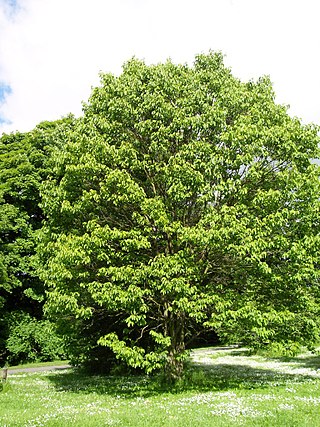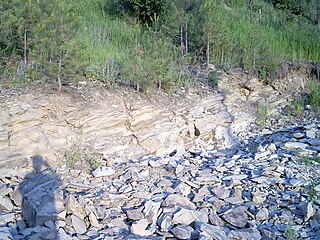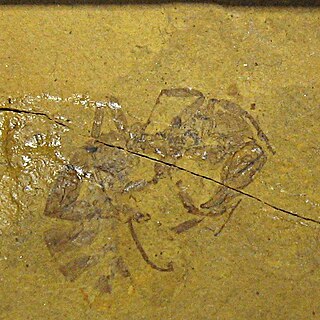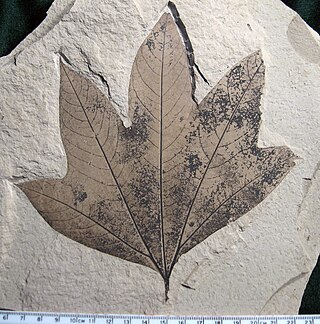
Ginkgoales are a gymnosperm order containing only one extant species: Ginkgo biloba, the ginkgo tree. It is monotypic, within the class Ginkgoopsida, which itself is monotypic within the division Ginkgophyta. The order includes five families, of which only Ginkgoaceae remains extant.

Gastornis is an extinct genus of large flightless birds that lived during the mid Paleocene to mid Eocene epochs of the Paleogene period. Fossils have been found in Europe, Asia and North America, with the remains from North America originally assigned to the genus Diatryma.

Palmoxylon is an extinct genus of palm named from petrified wood found around the world.

Uintatherium is an extinct genus of herbivorous mammal that lived during the Eocene epoch. Two species are currently recognized: U. anceps from the United States during the Early to Middle Eocene and U. insperatus of Middle to Late Eocene China.
Formicium is an extinct collective genus of giant ants in the Formicidae subfamily Formiciinae. The genus currently contains three species, Formicium berryi, Formicium brodiei, and Formicium mirabile. All three species were described from Eocene aged sediments.

Miacis is an extinct genus of placental mammals from clade Carnivoraformes, that lived in North America from early to middle Eocene.

Daphoenus is an extinct genus of bear dogs. Daphoenus inhabited North America from the Middle Eocene to the Middle Miocene, 37.2—16.0 Mya, existing for approximately 21 million years.

Hovenia is a small genus of deciduous trees or shrubs in the family Rhamnaceae. They occur naturally from India to Japan. The Japanese, or Oriental raisin tree, Hovenia dulcis, is the best known species, as it is often planted in gardens outside Asia.

The Baltic region is home to the largest known deposit of amber, called Baltic amber or succinite. It was produced sometime during the Eocene epoch, but exactly when is controversial. It has been estimated that these forests created more than 100,000 tons of amber. Today, more than 90% of the world's amber comes from Kaliningrad Oblast of Russia. It is a major source of income for the region; the local Kaliningrad Amber Combine extracted 250 tonnes of it in 2014, 400 tonnes in 2015.

The McRae Formation is a geological formation exposed in southern New Mexico whose strata date back to the Late Cretaceous. Dinosaur remains are among the fossils that have been recovered from the formation.

Iteaceae is a flowering plant family of trees and shrubs native to the eastern USA, southeastern Africa, and south and Southeastern Asia. Some older taxonomic systems place the genus Itea in the family Grossulariaceae. The APG III system of 2009 includes the former Pterostemonaceae in Iteaceae. Consequently, it now has two genera with a total of 18 known species.

Specimen Ridge, el. 8,379 feet (2,554 m) is an approximately 8.5-mile (13.7 km) ridge along the south rim of the Lamar Valley in Yellowstone National Park. The ridge separates the Lamar Valley from Mirror Plateau. The ridge is oriented northwest to southeast from the Tower Junction area to Amethyst Mountain. The ridge is known for its abundance of amethyst, opal and petrified wood. It was referred to as Specimen Mountain by local miners and was probably named by prospectors well before 1870. The south side of the ridge is traversed by the 18.8-mile (30.3 km) Specimen Ridge Trail between Tower Junction and Soda Butte Creek. The trail passes through the Petrified Forest and over the summit of Amethyst Mountain el. 9,614 feet (2,930 m).

Sinopa is a genus of hyaenodontid mammal from family Sinopidae, that lived in North America and Asia during the early to middle Eocene.

The Klondike Mountain Formation is an Early Eocene (Ypresian) geological formation located in the northeast central area of Washington state. The formation is comprised of volcanic rocks in the upper unit and volcanic plus lacustrine (lakebed) sedimentation in the lower unit. the formation is named for the type location designated in 1962, Klondike Mountain northeast of Republic, Washington. The formation is a lagerstätte with exceptionally well-preserved plant and insect fossils has been found, along with fossil epithermal hot springs.

Myrmeciites is an extinct form genus of bulldog ants in the subfamily Myrmeciinae of the family Formicidae, which contains three described species and two fossils not placed beyond the genus level. Described in 2006 from Ypresian stage deposits, all three of the described species and one unplaced fossil are from British Columbia, Canada, while the second unplaced fossil is from Washington State, USA. These ants were large, with the largest specimens collected reaching 3 centimetres (1.2 in). The behaviour of these ants would have been similar to extant Myrmeciinae ants, such as solitary foraging, nesting either in the soil or trees, and leaving no pheromone trail to food sources. Due to the poor preservation of these ants, their phylogenetic position among Myrmeciinae is unclear, and no type species has been designated. These ants are classified as incertae sedis in Myrmeciinae, but some writers have classified it as incertae sedis within the insect order Hymenoptera. This reclassification, however, has not been accepted; instead, Myrmeciites remains in Myrmeciinae.

Eulithomyrmex is an extinct genus of ant in the formicid subfamily Agroecomyrmecinae. The genus contains two described species, Eulithomyrmex rugosus and Eulithomyrmex striatus. Eulithomyrmex is known from a group of Late Eocene fossils which were found in North America.
Amethyst Mountain, el. 9,609 feet (2,929 m) is the highest peak and central part of a northwest – southeast trending ridge that lies between the Lamar River to the northeast and Deep Creek to the southwest within Park County, Wyoming. From northwest to southeast, this ridge consists of Specimen Ridge, Amethyst Mountain, and the Mirror Plateau in Yellowstone National Park. The nearest town is Silver Gate, Montana, which is 19.2 miles away.

Macginitiea is an extinct genus in the family Platanaceae ranging from the Late Paleocene to Late Eocene of North America, known from the Clarno Formation of central Oregon. The genus is strictly used to describe leaves, but has been found in close association with other fossil platanoid organs, which collectively have been used for whole plant reconstructions. Macginitiea and its associated organs are important as together they comprise one of the most well-documented and ubiquitous fossil plants, particularly in the Paleogene of North America.

Ignacius is a genus of extinct mammal from the early Cenozoic era. This genus is present in the fossil record from around 62-33 Ma. The earliest known specimens of Ignacius come from the Torrejonian of the Fort Union Formation, Wyoming and the most recent known specimen of Ignacius was found in the Medicine Pole Hills of North Dakota. Ignacius is one of ten genera within the family Paromomyidae, the longest living family of any plesiadapiforms, persisting for around 30 Ma during the Paleocene and Eocene epochs. The analyses of postcranial fossils by paleontologists suggest that members of the family Paromomyidae, including the genus Ignacius, most likely possessed adaptations for arboreality.

Alberta Maria Wilhelmina "Bep" Mennega was a Dutch botanist renowned for her studies into the anatomy of wood and plant systematics. The standard author abbreviation Mennega is used to indicate this person as the author when citing a botanical name.


















